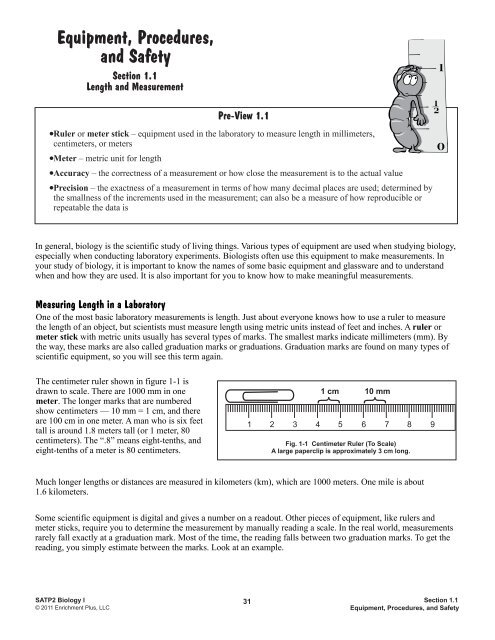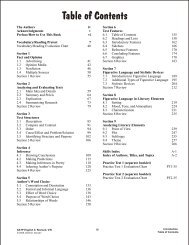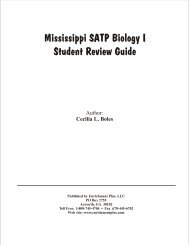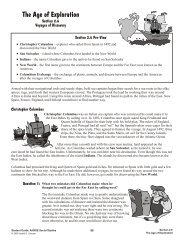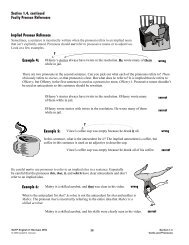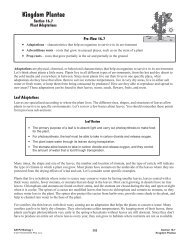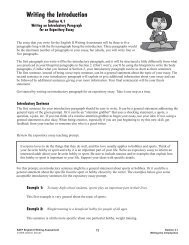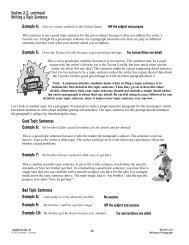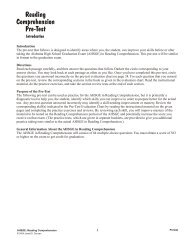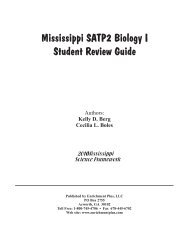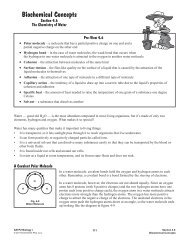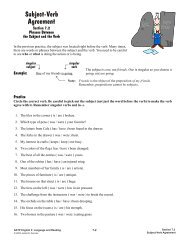Mississippi SATP2 Biology I Student Review Guide - Enrichment Plus
Mississippi SATP2 Biology I Student Review Guide - Enrichment Plus
Mississippi SATP2 Biology I Student Review Guide - Enrichment Plus
You also want an ePaper? Increase the reach of your titles
YUMPU automatically turns print PDFs into web optimized ePapers that Google loves.
Equipment, Procedures,<br />
and Safety<br />
Section 1.1<br />
Length and Measurement<br />
! Ruler or meter stick – equipment used in the laboratory to measure length in millimeters,<br />
centimeters, or meters<br />
!Meter – metric unit for length<br />
Pre-View 1.1<br />
!Accuracy – the correctness of a measurement or how close the measurement is to the actual value<br />
!Precision – the exactness of a measurement in terms of how many decimal places are used; determined by<br />
the smallness of the increments used in the measurement; can also be a measure of how reproducible or<br />
repeatable the data is<br />
In general, biology is the scientific study of living things. Various types of equipment are used when studying biology,<br />
especially when conducting laboratory experiments. Biologists often use this equipment to make measurements. In<br />
your study of biology, it is important to know the names of some basic equipment and glassware and to understand<br />
when and how they are used. It is also important for you to know how to make meaningful measurements.<br />
Measuring Length in a Laboratory<br />
One of the most basic laboratory measurements is length. Just about everyone knows how to use a ruler to measure<br />
the length of an object, but scientists must measure length using metric units instead of feet and inches. A ruler or<br />
meter stick with metric units usually has several types of marks. The smallest marks indicate millimeters (mm). By<br />
the way, these marks are also called graduation marks or graduations. Graduation marks are found on many types of<br />
scientific equipment, so you will see this term again.<br />
The centimeter ruler shown in figure 1-1 is<br />
drawn to scale. There are 1000 mm in one<br />
meter. The longer marks that are numbered<br />
show centimeters — 10 mm = 1 cm, and there<br />
are 100 cm in one meter. A man who is six feet<br />
tall is around 1.8 meters tall (or 1 meter, 80<br />
centimeters). The “.8” means eight-tenths, and<br />
eight-tenths of a meter is 80 centimeters.<br />
1 cm 10 mm<br />
1 2 3 4 5 6 7 8 9<br />
Fig. 1-1 Centimeter Ruler (To Scale)<br />
A large paperclip is approximately 3 cm long.<br />
Much longer lengths or distances are measured in kilometers (km), which are 1000 meters. One mile is about<br />
1.6 kilometers.<br />
Some scientific equipment is digital and gives a number on a readout. Other pieces of equipment, like rulers and<br />
meter sticks, require you to determine the measurement by manually reading a scale. In the real world, measurements<br />
rarely fall exactly at a graduation mark. Most of the time, the reading falls between two graduation marks. To get the<br />
reading, you simply estimate between the marks. Look at an example.<br />
<strong>SATP2</strong> <strong>Biology</strong> I<br />
© 2011 <strong>Enrichment</strong> <strong>Plus</strong>, LLC<br />
31<br />
Section 1.1<br />
Equipment, Procedures, and Safety


